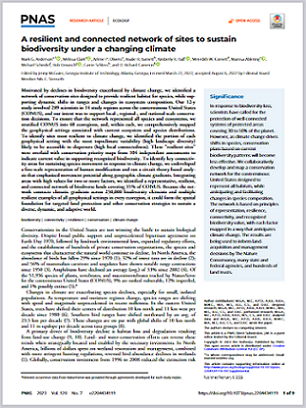
Motivated by declines in biodiversity exacerbated by climate change, we identified a network of conservation sites designed to provide resilient habitat for species, while supporting dynamic shifts in ranges and changes in ecosystem composition. Our 12-ystudy involved 289 scientists in 14 study regions across the conterminous United States(CONUS), and our intent was to support local-, regional-, and national-scale conservation decisions. To ensure that the network represented all species and ecosystems, we stratified CONUS into 68 ecoregions, and, within each, we comprehensively mapped the geophysical settings associated with current ecosystem and species distributions. To identify sites most resilient to climate change, we identified the portion of each geophysical setting with the most topo climate variability (high landscape diversity)likely to be accessible to dispersers (high local connectedness). These “resilient sites” were overlaid with conservation priority maps from 104 independent assessments to indicate current value in supporting recognized biodiversity. To identify key connectivity areas for sustaining species movement in response to climate change, we co-developed a fine-scale representation of human modification and ran a circuit-theory-based analysis that emphasized movement potential along geographic climate gradients. Integrating areas with high values for two or more factors, we identified a representative, resilient, and connected network of biodiverse lands covering 35% of CONUS. Because the net-work connects climatic gradients across 250,000 biodiversity elements and multiple resilient examples of all geophysical settings in every ecoregion, it could form the spatial foundation for targeted land protection and other conservation strategies to sustain a diverse, dynamic, and adaptive world.












